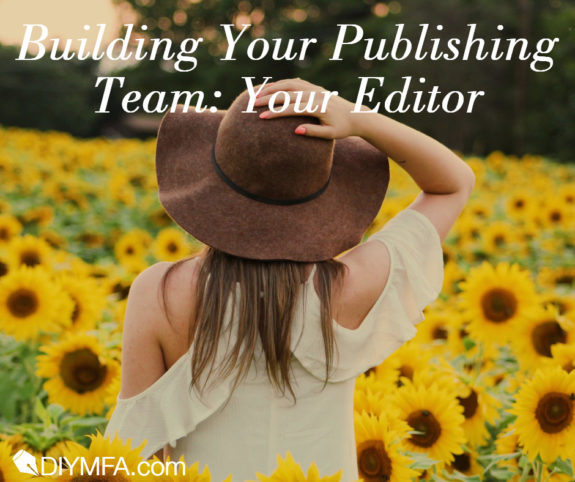Indie publishing can be a lean operation. That’s one of the advantages—you’re in control of your publishing timeline. But lean shouldn’t mean a solo act. You need other creative talent on your team, and in this post and the next we’ll talk about the most important team members:
- Your editor
- Your cover designer
Some people might argue the cover designer’s the most important team member. It’s true that your cover is your first chance to attract a browsing reader, and if it looks amateurish, that reader will give it a hard pass. But chances are you’re not there yet. You have a draft manuscript, a partial draft, or maybe an idea. You’ve got to have something ready to publish before you hire a cover designer.
That’s why an editor’s got to be the first person you bring on to your team.
Every Writer Needs an Editor
We care about our stories, but let’s face it: sometimes we can get a little too close to them. An editor provides a fresh set of eyes that can help you identify what’s not working and why.
An editor isn’t a sadist with a lust for red ink. She’s a professional who derives satisfaction from helping an author deliver the best story she or he can tell. A good editor respects your authorial voice. In my experience, some of the best editors are writers themselves. Because they have their own creative outlets, they understand the different spheres the author and editor occupy. They also appreciate the professional contributions a good editor brings to a project.
Can’t beta readers provide the same service (for free)?
No. Beta readers can provide a very important function in your writing and publishing process, but they’re not a substitute for a talented editor. If you employ a team of beta readers, you’ve suddenly got a half-dozen or more people offering their suggestions, some of which will directly contradict one another. Unless your beta readers are also experienced writers, they can’t offer the same structural guidance a professional editor can. Save their valuable contributions for the marketing stage of the project.
Okay, then. What kind of editor do I need, and how do I find one?
It’s a bit misleading to say you need to hire an editor. The truth is, there are several different types of editing, and the same person likely won’t provide all the different services. The most important types of editing are developmental editing, copyediting, and proofreading. They come at different points in the publishing process, and you need every one of them.
- A developmental editor works on the big picture, helping you to shape your story arc, build your characters, address plot holes, enhance thematic elements, and fix all manner of structural flaws. This person needs to be someone whose judgment you trust and whose opinion you respect.
- A copyeditor addresses grammatical and stylistic issues in a developmentally sound manuscript. She or he might identify writing habits you didn’t know you had. My copyeditor for my first book, Barb Goffman, pointed out my crutch words and now I watch for them every time I draft. Use too much passive voice? A copyeditor will call that out. Copyeditors can also assist you with fact-checking, consistency and continuity issues, pacing, and flow.
- A proofreader reviews the composed page proofs of the book just before the book is published. Proofreaders find grammatical and typographical errors that got overlooked when entering the copyeditor’s changes. They look for composition errors like widows and orphans, unbalanced pages, dropped text, and other problems. The proofreader forms the last line of defense before the book hits the stands.
In the age of digital publishing, you can fix errors after the book’s been published, but you don’t want your readers emailing you with a catalogue of errors. You’ve worked hard. Why put out a product that reflects poorly on your work?
How to Find an Editor
First, do yourself a favor and decline the offer from Aunt Bertha, who taught seventh-grade English for twenty years, to edit your book (if you’re really short on cash, she might proofread it). If you want your book to signal a professional effort, hire a professional. It’s that simple.
Many services online connect creatives with professionals. I met some of my team on Reedsy, but I know authors who’ve found great team members on Kboards as well. The Editorial Freelancers Association offers thoughtful resources and a job board where you can post details about your project for their members to consider. New York Book Editors is an editorial matchmaking service. Ask around on social media. Word-of-mouth reputation means a lot. If there’s a literary magazine you read and respect, check their masthead and inquire whether any of their staff would take on a contract project.
How to Hire an Editor
As with hiring any professional, do your due diligence.
Most professional editors will list the projects they’ve edited or will make references available to prospective clients. Check those sources out (and be wary if they won’t do one or the other). If you get references, ask the clients about their experience. Services like Reedsy can accelerate this process because they’ve already vetted the professionals in their database, and clients’ reviews appear on their profiles. In that case, you can spend a day looking at the books they’ve worked on to get a sense for the finished work.
Be willing to pay a professional fairly for their work (consult the Editorial Freelancers Association for typical pay rates). Talk frankly about what you need, what the editor will do, and what the deliverable will be at the end of the process. An editor can work magic on your manuscript, but the editor herself isn’t magical. She can’t read your mind. As with any professional relationship, good communication about expectations will yield the best results.
Brooke Warner makes several good recommendations on Ingram Spark’s blog, but I think her best advice is to hire a prospective editor for a two- to five-hour test run. It’s a small investment up front to make sure you find someone who’s a good fit for you.
Finally, make sure you sign a contract for the project. It will protect both of you in case of a dispute. Services like Reedsy include a contract as part of their process, but make sure you read it, and understand and agree to the terms, before you sign. If you use a boilerplate agreement off the Internet, hire an attorney to revise it to fit your needs. This up-front investment, which may take less than an hour of the attorney’s time, can pay major dividends down the road. Plus, you can use the contract for future projects.
Recreate a Lost Process
With independent publishing, you can craft for yourself the kind of publishing experience that was the standard a few generations ago: the chance to work, over the course of many books, with the same team of professionals who want to contribute to your growth as a writer.
Nowadays in traditional publishing, editors frequently move from publishing house to publishing house, but they can’t bring their projects with them. That means your book might get bought by an editor who loves it and is excited to work with you, but three months later that editor might take another job…leaving your book to be reassigned to someone who isn’t nearly as invested in you. With independent publishing, you can select a partner for the long haul. Choose wisely, and you can build a partnership for a long and fruitful future.
In my next post, we’ll talk about how to hire and work with another key team member—your cover designer.
 Helen J. Darling writes contemporary women’s fiction. Her first novel, I’ll Know Me When I Find Me, was self-published in January 2018. You can connect with her at itshelendarling.com and on Instagram at @itshelendarling.
Helen J. Darling writes contemporary women’s fiction. Her first novel, I’ll Know Me When I Find Me, was self-published in January 2018. You can connect with her at itshelendarling.com and on Instagram at @itshelendarling.







